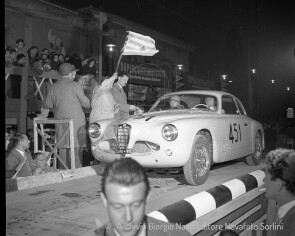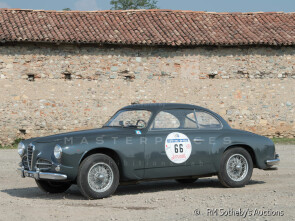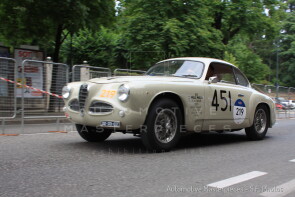
1953 Alfa Romeo 1900 C Sprint
ON/OFF
Why am I an Automotive Masterpiece?
In 1950, Alfa Romeo thought it was time to replace the glorious but now old pre-war 6C2500 and to make a car keeping up with new technologies that now were proposing the body integrated into the chassis: a car, so to speak, modern. The car, entirely designed under the supervision of Orazio Satta Puliga, born and developed entirely at the Portello plant, would have contained, like Alfa Romeo tradition, several mechanical refinements. The Alfa Romeo 1900 was built between 1950 and 1959 and was the first entirely new post-war project of the company. It was the first Alfa Romeo built entirely on an assembly line, starting the high-quality mass production at the Portello. First monocoque production car and the first Alfa Romeo with left-hand drive. The heart, as in every Alfa Romeo, was the engine. With the 1900 the Milanese house abandoned the six and eight cylinders engines in favor of a fractioning that allowed a lower taxation. Instead, they were in light alloy, with two overhead camshafts and hemispherical chambers. Giuseppe Busso opted for an independent double wishbones front suspension. The rear suspension was new: the live axle with coil springs was connected to the chassis by two lower struts and a top triangle. The aluminum drum brakes were finned and the rims of the wheels equipped with slits to help cooling. The 1900 was one of the very first automobiles in the world to adopt radial tires. The configuration, the design of all the monocoque laminates and even the study of production equipment were carried out at the Portello. The first road exit took place on March 2, 1950 with Consalvo Sanesi driving. The shape was the result of a refining by Orazio Satta Puliga and Antonio Alessio. He consulted Gaetano Ponzoni, of the Touring that suggested significant finishing touches. The gear lever by the steering wheel allowed two three-seater sofas. The bakelite steering wheel had a horn ring. The dashboard had a large semi-circular speed indicator with oil pressure gauge and fuel gauge on each side. In the middle, the housing for the radio or the tachometer. The 1900 four-door sedan was the only model available until the introduction of the 1900C coupe in 1951 and the TI saloon in 1952, it was equipped with a 1.9-liter engine that delivered 90 hp and reached a top speed of 171 km/h. Production ceased in 1959 with a total of 17,243 cars produced in the various models. It was the “Alfona” for the most, the “Pantera” for excellence, “the family car that wins the races” in the slogans. She was much loved and also very feared.
Iginio Alessio, then general manager of Alfa Romeo, was concerned for the viability of the independent Italian Coachbuilding industry–the advent of the unibody chassis design was threatening to put the "carrozzerie" out of business. Alessio was also a personal friend of Gaetano Ponzoni co-owner of Carrozzeria Touring Superleggera, thus from 1951-1958 Alfa Romeo built five different variations of the 1900 unibody chassis specifically for independent coachbuilders. Alfa Romeo gave official contracts to Touring to build the sporty 1900 Sprint coupé and to Pinin Farina to build an elegant four-seat Cabriolet and Coupé. The availability of a suitable chassis led to many other coachbuilders to build versions of the 1900. Carrozzeria Zagato built a small series of coupés with the unofficial designation of 1900 SSZ, designed for racing. One-off specials were numerous.
The Alfa Romeo 1900 C Sprint with chassis no. AR1900C*01247* was built in 1953 with "Superleggera" Touring bodywork. The strong shaping of the front was inspired by the stylistic solutions already seen on the "Villa d'Este" coupé of 1949. The floor for the bodybuilders had been developed by shortening the wheelbase of the sedan by 13 cm. According to different hypotheses, the letter "C" in the name would indicate Corto (short wheelbase) or Carrozzieri (for coachbuilders). The C Sprint's engine was boosted by 20 hp. As regards the Touring coupé, there were two series: the first examples had the particularity of the door that extended to the base of the bodywork and the small, very compact instrumentation. Subsequently the sill became conventional, i.e. framing the door. Other peculiarities of the first examples were the thin bumpers without overriders, later larger with overriders, produced by Brunsig. The front lights were recessed, and the door handles almost disappeared. The upholstery could be in leather or fabric and imitation leather, the carpets in wool and rubber carpets. The rear light clusters were round, like those of the sedan, including the position light and the stop signal. The chassis no. AR1900C*01247* is one of the examples from the first series. Built in 1952 according to the authoritative Luigi Fusi, its certificate of origin is however dated March 2, 1953. It is therefore one of the very few first series (with extended doors) dated 1953, the switch between the series having taken place at the end of 1952. The car has the sporty option of a floor shifter and not on the steering wheel as standard. The car passes through the hands of Ugo Bormioli, a well-known gentleman driver and Alfa Romeo dealer for the Veneto region. The first owner is the company C.I.P.I. - S.r.l. (Costruzione Impianti Petroliferi Industriali) of Venice, but on April 20 it was registered to Amedeo Munarini, a racing driver too, who five days later took part in the XX Mille Miglia (with Lodovico Negro at the wheel), where the car was 29th in class. It was a truly honorable debut, but there is no further news of any sporting use of the car. Chassis no. AR1900C*01247* changed owners until it became part, presumably at the end of the 90s, of Luigi Compiano's gigantic collection of vintage cars, the subject of a much-talked-about judicial case. According to an expert report, Compiano suffered from a disorder that had affected his ability to understand and will; the Treviso entrepreneur accumulated cars, motorbikes, and boats, purchased over the course of about eighteen years, cramming them into eleven warehouses in an industrial area on the outskirts of Treviso, without ever showing them off in public. To do so, he used at least 36 million euros, misappropriated from the vaults of the family's securities company, causing its bankruptcy. As partial compensation, RM Sotheby's was tasked with organizing an auction during Milano Autoclassica: "2000 Ruote". Around one hundred trucks traveled between Treviso and the Milan Fair, transporting 434 cars, 159 motorcycles, 58 boats and 134 bicycles for a total of 817 lots which, between November 25 and 27, 2016, were sold for a total of € 51 million, in one of the richest automotive auctions ever. After years of oblivion, abandoned in one of the collection's warehouses, chassis no. AR1900C*01247* was one of the protagonists of the auction, presented with the road setup (including bumpers on) and painted iron grey, with original documents and matching numbers. It was sold for just under €400,000. This was followed by a complete restoration costing over €100,000 and carried out by the Dutch Mugello Engineering in a record time of four months, to be entered in the 2017 Mille Miglia. The car was restored to its original light hazelnut color and in the livery of the 1953 Mille Miglia without bumpers.





